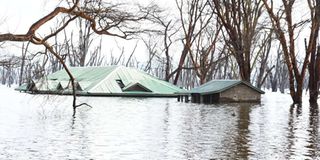Premium
Weathermen seek to unravel mystery of rising lakes in Rift Valley

Submerged buildings at Lake Nakuru National Park's main gate following rising water levels at the lake in this picture taken on October 1, 2020.
What you need to know:
- Initial findings by a group of scientists carrying out research on eight lakes within the Rift Valley established that poor urban drainage basins made up of concrete and impermeable materials was the cause of flooding in low lying areas such as the lake basin.
- The scientist also said that increased rainfall, as a result of climate change, the El-Niño phenomenon that has occurred over the years and overflowing rivers have contributed to the current situation.
Environmentalist and climate experts are conducting research to establish the cause of rising lakes within the Rift Valley region.
The Kenya Meteorological Department Chairman, Dr Richard Mwita, said they are looking into the rate at which the lakes have been rising and future projections.
Speaking at a Naivasha hotel on Wednesday, Dr Mwita said they were also studying the possible effects on communities living near the riparian land around the lakes.
“The solution is about what should be done in the short-term to help save some of the dire situations,” said Dr Mwita.
He clarified that diverse causes are linked to the increasing water levels, with experts from the geological department attributing it to the movement of tectonic plates.
“Those using remote sensing are talking about changes in the vegetation and the land cover where people occupy areas that were originally lakes,” Dr Mwita said.
Rising temperatures
“There are combinations of theories but a Kenya Meteorological Department case study conducted recently noted a correlation between the rainfall patterns and the rising lake levels in the last 30 years,” he said.
He said the findings by the department are likely to be officially released in the coming weeks.
Dr Mwita acknowledged that rainfall has been increasing, coupled with rising temperatures.
“We are waiting for proper data to establish whether the issue of sedimentation was also affecting the lake levels,” he said.
Initial findings by a group of scientists carrying out research on eight lakes within the Rift Valley established that poor urban drainage basins made up of concrete and impermeable materials was the cause of flooding in low lying areas such as the lake basin.
They also cited seismic activities that occurred within the area in the past, leading to siltation and increased inflow of water into the lake from various surrounding aquifers.
The scientist also said that increased rainfall, as a result of climate change, the El-Niño phenomenon that has occurred over the years and overflowing rivers have contributed to the current situation.





